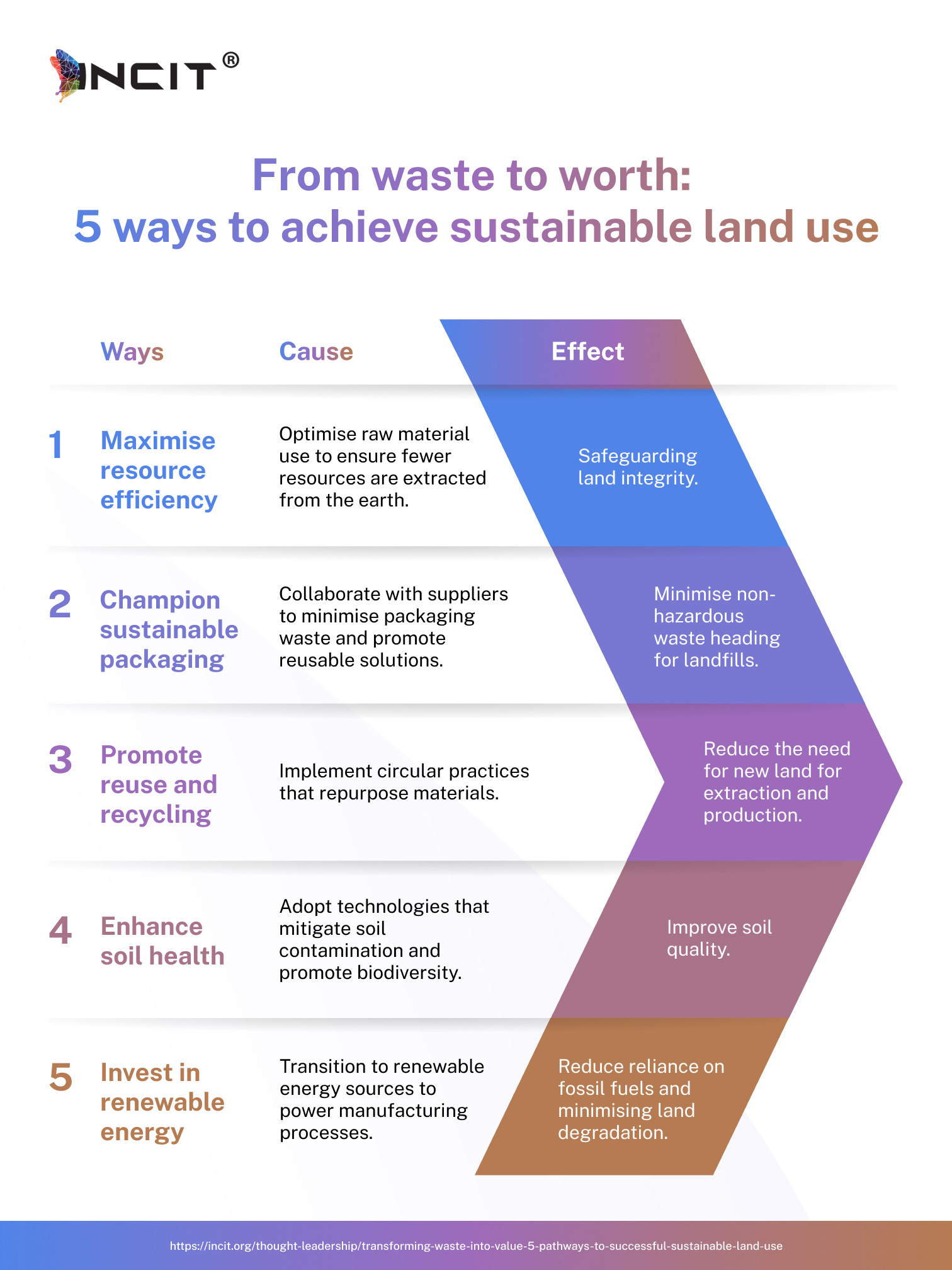Ang pagmamanupaktura ay isa sa pinakamalaking pinagmumulan ng polusyon sa buong mundo, at ito ay malamang na hindi magbago habang patuloy na lumalaki ang pangangailangan ng mga mamimili para sa mga produkto. Ang mga prosesong pang-industriya, lalo na sa pagmimina at pagmamanupaktura, ay dating pangunahing nag-aambag sa polusyon sa lupa, at ang paggamit ng mga kemikal—hindi kasama ang mga parmasyutiko—ay inaasahang tataas ng 85 porsiyento sa 2030. Gayunpaman, ang mga tagagawa ay hindi dapat maging idle pagdating sa pagkilos sa klima. Dapat silang magkaroon ng aktibong papel sa pagbabawas ng basura at pagtataguyod ng napapanatiling paggamit ng lupa. Sa pamamagitan ng pagbabawas ng basura, ang mga komunidad ay mas protektado at hindi negatibong naaapektuhan ng mga negosyo na nangunguna sa pinabuting kalusugan ng kapaligiran ng lugar sa mga aktibidad na nagpapababa ng polusyon at nagpapanatili ng mga natural na ekosistema.
Paano mangunguna ang mga tagagawa? Una, maaari nilang bawasan ang kanilang mga ekolohikal na bakas ng paa at gamitin ang lupa nang matibay sa pamamagitan ng pagbabawas ng basura, simula sa pag-recycle, pag-compost, at responsableng pagkonsumo. Ayon sa McKinsey & Co., ang mundo ay nangangailangan ng karagdagang 70-80 milyong ektarya ng lupa upang matugunan ang mga pangangailangan ng sangkatauhan para sa pagkain at panggatong. Saan magmumula ang matitirahan na lupaing ito? Bagama't ito ay isang problema para sa lahat, ang mga tagagawa ay dapat kumilos nang mabilis upang magtatag ng isang matatag na pundasyon para sa napapanatiling paggamit ng lupa sa lalong madaling panahon at itakda ang benchmark para sa iba pang mga sektor na sundin.
Narito kung paano mo maaaring gamitin ang mga diskarte sa berdeng pagmamanupaktura at yakapin ang mga prinsipyo ng paikot na ekonomiya, tulad ng pagliit ng basura, pag-promote ng muling paggamit ng produkto, at pag-optimize ng kahusayan sa mapagkukunan para sa isang mas responsableng pamamahala sa lupa at diskarte sa pagbabagong-buhay ng lupa.

Upang epektibong maipatupad ang mga kasanayang ito, manalig sa Consumer Sustainability Industry Readiness Index (COSIRI), isang malawak na kinikilalang balangkas para sa pagtatasa ng sustainability maturity sa mga pangunahing lugar tulad ng shop floor, supply chain, logistics, diskarte, at mga panganib. Nagbibigay ito sa mga CEO ng mahahalagang insight para sa madiskarteng paggawa ng desisyon, na nagpo-promote ng mga napapanatiling kasanayan sa mga operasyon. Handa nang gumawa ng makabuluhang epekto sa negosyo? Tuklasin ang higit pa tungkol sa kung paano maaaring kumilos ang INCIT bilang iyong ekspertong gabay, na sumusuporta sa iyong organisasyon tungo sa mas napapanatiling mga operasyon na nagreresulta sa mga pinahusay na kasanayan sa paggamit ng lupa sa pamamagitan ng nakikipag-ugnayan sa amin.
Mga Madalas Itanong Tungkol sa Mga Istratehiya para sa Sustainable Land Use sa Manufacturing
Ano ang Sustainable Land Use sa Manufacturing?
Ang napapanatiling paggamit ng lupa sa pagmamanupaktura ay kinabibilangan ng pagpaplano at pamamahala ng lupang pang-industriya upang mabawasan ang epekto sa kapaligiran, bawasan ang basura, at itaguyod ang pangmatagalang kahusayan sa mapagkukunan habang sinusuportahan ang paglago ng ekonomiya at kapakanan ng komunidad.
Paano Magiging Halaga ang Basura sa Paggamit ng Lupang Pang-industriya?
Ang basura ay maaaring gawing halaga sa paggamit ng lupang pang-industriya sa pamamagitan ng muling paggamit ng mga materyales, pag-reclaim ng mga brownfield site, paggamit ng mga byproduct para sa enerhiya o konstruksyon, at pagsasama ng mga prinsipyo ng circular economy sa pag-develop ng site.
Ano ang mga Benepisyo ng Sustainable Land Use para sa mga Manufacturers?
Ang napapanatiling paggamit ng lupa ay tumutulong sa mga tagagawa na bawasan ang mga panganib sa kapaligiran, babaan ang mga gastos sa pagpapatakbo, pagbutihin ang pagsunod sa mga pamantayan ng ESG, pagandahin ang reputasyon ng tatak, at magbukas ng bagong kita sa pamamagitan ng mga pagbabago sa waste-to-value.
Paano Sinusuportahan ng Pagpaplano ng Paggamit ng Lupa ang Pagpapanatili ng Kapaligiran?
Sinusuportahan ng pagpaplano ng paggamit ng lupa ang pagpapanatili ng kapaligiran sa pamamagitan ng pagbabawas ng pagkagambala sa tirahan, pamamahala ng mga mapagkukunan nang mahusay, pagpigil sa polusyon sa lupa at tubig, at pagpapagana sa muling paggamit ng mga kasalukuyang pang-industriyang lugar.
Ano ang Papel ng Circular Economy sa Sustainable Land Use?
Ang pabilog na ekonomiya ay gumaganap ng isang mahalagang papel sa napapanatiling paggamit ng lupa sa pamamagitan ng pagtataguyod ng materyal na muling paggamit, pagliit ng basura, at paghikayat sa mga closed-loop system kung saan ang lupa, mga mapagkukunan, at imprastraktura ay na-optimize para sa pangmatagalang paggamit.
Ano ang mga Halimbawa ng Waste-to-value Strategies sa Paggawa?
Kabilang sa mga halimbawa ang paggamit ng mga byproduct sa pagmamanupaktura para sa pagbuo ng enerhiya, pag-convert ng mga pang-industriyang basura sa mga hilaw na materyales para sa iba pang mga proseso, at pag-reclaim ng lupa para sa mga berdeng espasyo o renewable energy installation.
Paano Magagawang Muli ang Mga Site ng Brownfield para sa Sustainable na Paggamit?
Ang mga site ng Brownfield ay maaaring gawing muli sa pamamagitan ng remediation ng lupa, pag-upgrade ng imprastraktura, at pagsasama ng mga prinsipyo ng napapanatiling disenyo, na ginagawang produktibo, eco-friendly na pang-industriya o mga asset ng komunidad ang hindi nagamit o kontaminadong lupa.
Paano Nakakatulong ang Sustainable Land Use sa Esg Goals?
Ang napapanatiling paggamit ng lupa ay nag-aambag sa mga layunin ng ESG sa pamamagitan ng pagbabawas ng epekto sa kapaligiran (E), pagsuporta sa mga lokal na komunidad sa pamamagitan ng responsableng pag-unlad (S), at paghahanay sa pamamahala ng lupa sa mga transparent na gawi sa pamamahala (G).
Anong mga Hamon ang Kinakaharap ng Mga Kumpanya sa Pagpapatupad ng Sustainable Land Use Strategy?
Kasama sa mga hamon ang mataas na gastos sa remediation, pagiging kumplikado ng regulasyon, kakulangan ng teknikal na kadalubhasaan, paglaban ng stakeholder, at limitadong access sa mga napapanatiling materyales o mga opsyon sa pagpopondo para sa muling pagpapaunlad ng site.


